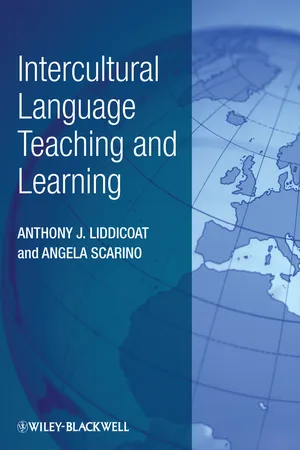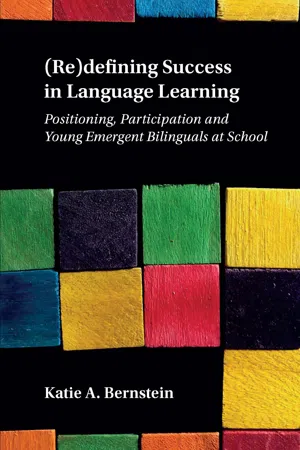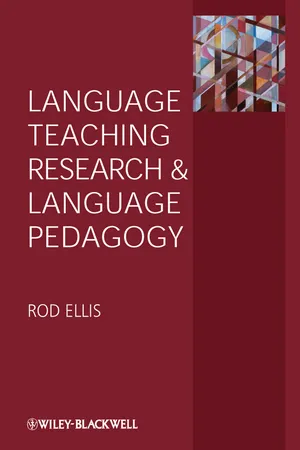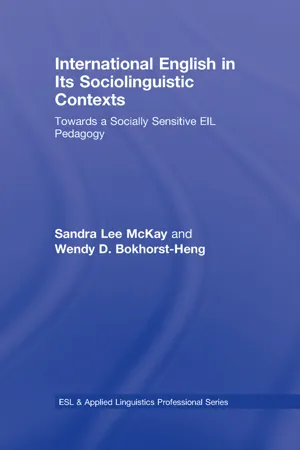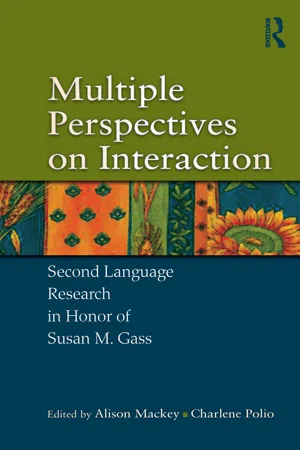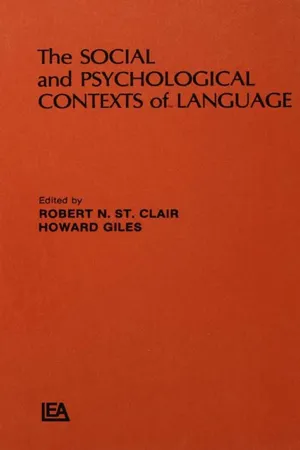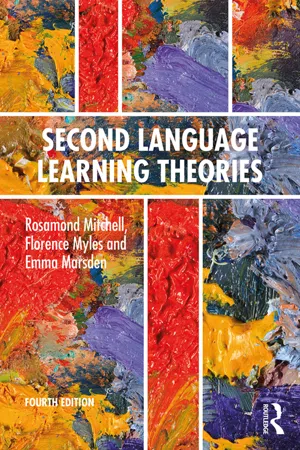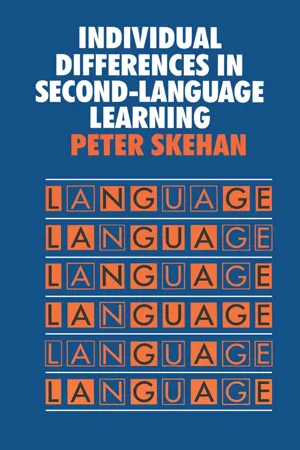Languages & Linguistics
Interactionist Theory
Interactionist Theory in linguistics emphasizes the role of social interaction in language development and use. It posits that language is shaped by the interactions between individuals and their environment, and that communication is a dynamic process influenced by social and cultural factors. This theory highlights the importance of context and social relationships in understanding language acquisition and usage.
Written by Perlego with AI-assistance
Related key terms
11 Key excerpts on "Interactionist Theory"
- eBook - ePub
- Anthony J. Liddicoat, Angela Scarino(Authors)
- 2013(Publication Date)
- Wiley-Blackwell(Publisher)
The theories described so far give salience to the internal processing of information in the mind of the individual learner. Further theoretical work on language learning considers the role of interaction. Building on Krashen’s (1982) notion of comprehensible input, Long (1985, 1996) proposes an interactive view of input whereby learners work at understanding each others’ meanings in interaction. Essentially, within this view comprehensible input becomes available in situations of social interaction. This is because the context of interaction provides opportunities for the negotiation of meaning. Through the process of negotiation, input becomes comprehensible as native speakers adjust or modify their language until learners show signs of understanding. This is not only a process of simplification, but also a process of clarification, elaboration, emphasis, or providing further contextual clues. The adjustment involves negotiation in order to clarify and confirm meaning in the particular instance in response to difficulties experienced by the learner. Long (1996, pp. 451–452) sees the negotiation for meaning that takes place in interaction as connecting input, internal learner capacities, particularly selective attention, and output in productive ways. The interactivity here remains focused on language understood as grammar, and is aimed at resolving communication problems: improving the comprehensibility of input, attention, and the need to produce output, within a computational metaphor. Interaction is needed to facilitate cognition and learning; it is a means to a learning end but not constitutive of learning itself in the sense of learning how to interpret, create, and exchange personal meanings. Furthermore, the link between increased opportunity for negotiation of meaning and improved learning is yet to be demonstrated empirically (Littlewood, 2004).Another important development in relation to interaction-based approaches to language learning is the recognition that output plays an important role in acquisition (Swain, 1995). Speaking and writing forces learners to attend to aspects of form that they do not need for comprehension purposes alone, and in the process of speaking and writing learners identify gaps, make hypotheses about how language works, and obtain feedback towards extending their understanding of the language. Within these interaction-based views, interaction plays a mediating role in learning in that it stimulates students to seek scaffolds or supports from peers or the teacher in order to fill gaps or extend their learning (Littlewood, 2004).In the theories discussed above, the emphasis is on cognitive processes that underlie second language learning. They are psychologically oriented theories that consider learning as developing in the mind of the individual. Interaction becomes the vehicle for stimulating various kinds of mental processes within the individual. It is one of the conditions for learning. Context is considered to be important but it is understood only as the immediate setting in which interaction takes place; it is not seen as shaping the interaction towards the exchange of meaning. Furthermore, language itself remains the substance of learning rather than also including significant “content” that is derived from other domains of knowledge and culture(s) of the target language being learned or the personal knowledge of the students themselves.Sociocultural theories, as the second family of theories, have developed in reaction to cognitive theories. They consider the relationship between thinking and the wider social, cultural, historical, and institutional context in which it occurs. The context itself is seen to be constitutive of learning. Within these theories social interaction is seen as the major means through which learning occurs. As Lantolf explains, “sociocultural theory holds that specifically human forms of mental activity arise in the interactions we enter into with other members of our culture and with the specific experiences we have with the artifacts produced by our ancestors and by our contemporaries” (2000, p. 79). Within the sociocultural family of theories the mental and the social are not seen as a dichotomy but rather as being in a dialectic relationship where each is shaped by and shapes the other. - eBook - ePub
Communication Counts
Speech and Language Difficulties in the Early Years
- Fleur Griffiths(Author)
- 2013(Publication Date)
- Routledge(Publisher)
6 Social interaction theories which suggest that language is a socio-cultural tool which develops out of social encounters as a consequence of human motivation to interact with others and to develop a concept of self (Vygotsky 1962; Bruner 1968). It is the latter theories with which this book is principally concerned since, as I will contend, they provide a basis for blending content and procedures into a unified assessment and intervention approach with young children. For an extended discussion of the usefulness of the various types of theory see Nelson (1993).Social interaction theory suggests that children learn to talk and practise their communication skills when they have a reason to do so, and that context determines the language structures that are used. Nelson (1993) summarises the primary assumptions of social interactionist theories of language development as follows:1 Language develops not because of any innate linguistic competence or because of strict reinforcement principles, but because human beings are motivated to interact socially and to develop concepts of self and others.2 The important elements of development are not abstract linguistic or cognitive structures or concrete verbal behaviours, but rather they are the phenomena of intentional and symbolic acts of speech, their conversational functions, their consequences for participants and their context-creating power and context-dependent properties.3 Language acquisition occurs in the content of dyadic, dynamic interactions which are motivated by the child’s drive to develop a concept of self and to interact with others socially (not isolated efforts to construct a grammar, or passive processes controlled by external reinforcers).4 Parents (and other conversational partners) contribute significantly to the language acquisition process by adjusting their linguistic input to be compatible with the child’s developing linguistic and communicative abilities and by supplying a scaffold.The important distinction between this approach and others outlined above is that it focuses on the processes - eBook - ePub
(Re)defining Success in Language Learning
Positioning, Participation and Young Emergent Bilinguals at School
- Katie A. Bernstein(Author)
- 2020(Publication Date)
- Multilingual Matters(Publisher)
While interaction plays a role in nearly all theories of second language acquisition, the view that interaction is both a place for language learning as well as for the construction of social relationships and structures is a broadly sociocultural one. Vygotskian sociocultural theory, which was brought to the field of Second Language Acquisition through the work of Rick Donato, Jim Lantolf, Merrill Swain and Steve Thorne, among others, theorizes that learning is a process of internalization and appropriation. Any new skill appears first on the social plane, through participation in interaction with others, and then, later, on the individual plane (Vygotsky, 1978). Through interaction, children learn to use artifacts, or cultural tools – more concrete ones, like spoons or markers, to more abstract ones, such as language and gesture – to mediate their goal-driven activity. For second language researchers who draw on Vygotskian sociocultural theory, interaction is at the core of language learning, which takes place through participation in ‘cultural, linguistic, and historically formed settings such as family life and peer group interaction’ (Lantolf & Thorne, 2007: 197). Far from simply providing input, interaction is the location of learning itself.Specifically, Lantolf (2000, 2013; Lantolf & Thorne, 2006, 2007) described interaction as mediating L2 learning in two important ways. First, it provides opportunities to understand and appropriate others’ intentional ways of using language to participate in activity. Second, it enables learners to use language in ways that are just beyond their individual capabilities, in their zones of proximal development, or the range of activities that a person cannot yet complete independently, but can in cooperation with another person. Donato (1994, 2000) and Swain (1997; Swain et al., 2002) described similar learning processes, which they called ‘collective scaffolding’ and ‘collaborative dialogue,’ respectively. Through these interactions with others, learners appropriate language that they can then rehearse in private speech or use productively in other interactions. Importantly, from a sociocultural perspective, development and learning are not individual processes. Instead, they involve appropriation and internalization of intro-individual social activity. Sociocultural theory thus dispenses with the dichotomy between the individual and the social, as well as between the cognitive and the cultural. All development, and the learning that precedes it, is both social and cultural. There is no ‘that which surrounds.’ This is also true in the second theoretical perspective Cole mentioned: practice theory.Language – and Human Activity – as Social PracticePractice theory was developed by sociologist Pierre Bourdieu (1977, 1990), as a way to overcome what he saw as three related and false dichotomies in sociological and anthropological research: objectivity and subjectivity, positivism and phenomenology, and structure and agency. The first in each set come together in the researcher striving to view human activity as an outsider, looking down from above in order to create a stable account of patterns and routines, by, for example, mapping the daily schedule in a prekindergarten classroom. The latter in each pair convene in attempts to understand the ‘native perspective,’ or personal experience of, say, being the new kid in school or the parent of a child with a disability. For Bourdieu, the former approach reduces human activity to acting out predetermined roles on stage or to executing prewritten plans, while the latter ignores everything outside individual experience, including the conditions, such as relations of power, that made that experience possible. With practice theory, Bourdieu sought to bridge the two and to understand how structure sets the conditions for human activity without determining it and how activity (re)produces those structures. He accomplished this through the notions of habitus and field. - eBook - ePub
- Rod Ellis(Author)
- 2012(Publication Date)
- Wiley-Blackwell(Publisher)
from the input. Interaction, however, does more than simply expose learners to input. It also serves to focus their attention on specific linguistic forms. In other words, it is more than just an input-machine; it helps to activate cognitive processes that are responsible for acquisition. For example, the negotiation of meaning and the negotiation of form induce attention to linguistic forms and provide opportunities for learners to modify their own output and in so doing create the conditions for acquisition to take place. Acquisition itself, however, is a mental phenomenon; it takes place inside the learner's head. As Van Lier (2000a) put it, ‘activity and interaction … relate to learning in indirect ways by feeding into cognitive processes that are going on in the brain and mind of the learner’ (p. 246).Interactionist-cognitive theories have spawned a number of hypotheses and constructs that have informed the research we will consider in this chapter and which I have explained in previous chapters. The key constructs are: (1) negotiation of meaning, (2) negotiation of form, (3) focus on form, (4) uptake, (5) modified output, (6) noticing and (7) noticing the gap.The essential differences between a sociocultural and interactionist-cognitive account of learning are summed up in the following two quotations.In situated social practices, use and learning are inseparable parts of the interaction. They appear to be afforded by topics and tasks and they seem to be related to specific people, with particularized identities, with whom new ways of behaving occur as the unfolding talk demands (Firth and Wagner, 2007: 812). - eBook - ePub
International English in Its Sociolinguistic Contexts
Towards a Socially Sensitive EIL Pedagogy
- Sandra Lee McKay, Wendy D. Bokhorst-Heng(Authors)
- 2017(Publication Date)
- Routledge(Publisher)
Chapter 6 Interactional sociolinguisticsIn this chapter we examine how interactional sociolinguistics can provide insight into the use of English in an era of globalization. The chapter begins with an overview of the central figures and tenets of interactional sociolinguistics. Using this background, we examine existing research regarding EIL interactions. Specifically, we explore the ways in which interactional sociolinguistics has been beneficial in providing insight on:f• English as a lingua franca (ELF) interactions;• the code-switching behavior of bilingual users of English; and• bilingual users’ attitudes toward code-switching.In each section we will consider the manner in which the topic has relevancy for EIL pedagogy.Defining interactional sociolinguistics
Historical development
Interactional sociolinguistics developed out of linguistics, sociology, and anthropology. Current interest in interactional sociolinguistics began largely as a reaction to Chomsky’s (1957) view of language as a fixed universal property of the human mind that exists devoid of context. A major challenge to Chomsky’s view of language was the work of Hymes (l974), a linguistic anthropologist, who argued that a description of language must take into account the social knowledge that individuals bring to linguistic interactions. Hymes argued that researchers interested in describing how language is used need to consider the context in which particular interactions take place and how this context affects the inter-action. Specifically, Hymes (1972) maintained that the following four questions must be raised in analyzing language use. - eBook - ePub
Multiple Perspectives on Interaction
Second Language Research in Honor of Susan M. Gass
- Alison Mackey, Charlene Polio(Authors)
- 2009(Publication Date)
- Routledge(Publisher)
If Long’s statement above is correct, then there is no need to compare learner performance in different social contexts. However, no empirical evidence is cited to support Long’s claim. Quite the contrary. Long asserts that it is up to other researchers to prove he is wrong. Long’s statement thus actually functions as a set of hypotheses that should be tested in SLA research as we move beyond the pale of academia. Does the way the learner acquires an L2 in and out of classrooms change if we look at specific aspects of the acquisition process? Specifically, in considering the role of social context in the interaction approach to SLA, do constructs that are central to the interaction approach—constructs such as attention, input, output, and corrective feedback—function the same, or differently, in classroom vs. non-academic contexts?This chapter takes the position that these constructs should be viewed, not as solely cognitive, but as sociocognitive, in that social setting influences all of them: attention, input, output (including sequences of L2 development), and corrective feedback. The chapter will focus on two central tenets of the interaction approach, as summarized by Mackey and Gass (2006), to explore ways that variationist research and theory can improve our understanding of the intricate interrelationships among social context, cognition, and the development of a linguistic system in SLA. I hope to show the relevance of a variationist perspective for research using the interaction approach.In the discussion below, I follow R. Ellis (2007b) in returning to a central distinction about sociolinguistic research that was made originally by Fasold (1984, 1990)—the distinction between the sociolinguistics of society (using language as a starting point for examining societal issues) and the sociolinguistics of language (examining the impact of social factors on the way language is used). As Ellis (2007b) points out, both types of sociolinguistics have generated research in SLA. Language socialization studies in SLA (usefully described in Duff, 2007) derive from the approach used in the sociolinguistics of society, whereas variation studies in SLA draw upon scholarship in the sociolinguistics of language (cf. Tarone, 2007a, 2007b). It is the latter discipline (the sociolinguistics of language, or variationist linguistics) I will rely on in discussing the tenets of the interaction approach. The two tenets of the interaction approach, as articulated by Mackey and Gass (2006) are:1. Attention (and noticing) is a central component in development. Some acquisition happens incidentally, but some type of focus on form is necessary for certain types of learning. 2. There is a link between interaction and learning with a focus on three major components of interaction: exposure (input), production (output), and feedback. - R. N. St. Clalr, H. Giles(Authors)
- 2013(Publication Date)
- Psychology Press(Publisher)
11 Obviously, this graphic representation is only a first approximation of the interdisciplinary nature of language, but it does provide some insight into how these language-related disciplines can effectively establish communicative links that will advance the goal of a fully integrated metaparadigm of language. It can also be of use, it can be argued, in task-force situations where scholars from various disciplines are brought together in order to solve a common problem. The perspectives that these scholars will bring to such an analysis will be determined, in part, by their communicative links within the network model. Depending on the nature of the problem to be resolved, some scholars will have more to contribute than others.CONCLUDING REMARKS
The contexts of language are varied. Each discipline brings with it a different perspective and consequently concentrates on diverse and sometimes unrelated problem areas. When sociologists view language as a social phenomenon, they raise questions about whether or not a speech community is united by means of an organic or a mechnical form of solidarity. The psychologists, on the other hand, are concerned with questions of either a developmental nature or its capacity as an instrument for human information processing. It is only when both these contexts are united into a broader framework that the relevance of social psychology can be appreciated as a new perspective on language. When this broader framework of social psychology, and symbolic interactionism in particular, is integrated into sociolinguistic theory, some interesting and challenging directions for research are opened up. The following, therefore, are suggestions for the establishment of an interdisciplinary paradigm for the language sciences. These focal points, then, suggest new frontiers on the parameters of linguistic theory.According to the concept of emergence, meanings are created through symbolic interaction. Each participant in a speech situation may bring a unique definition to a situation, but once social interaction begins, both parties influence each other, and the meanings that result are due to compromise and reassessment. This common phenomenon of emergence cannot be readily accommodated into current linguistic theory. For example, in the model of semantic interpretation that is characteristic of transformational theory (Chomsky, 1965), it is assumed that there is a homogeneous speech community. And all surface differences are shown to be nonexistent at the level of deep structure. If there is a homogeneous deep structure that underlies linguistic interaction, then the phenomenon of emergence has no basis for occurring. But it does occur. Evidently, the present model of transformational grammar needs to be revised in order to account for these facts.- eBook - ePub
- Kyoko Masuda, Carlee Arnett, Angela Labarca, Kyoko Masuda, Carlee Arnett, Angela Labarca(Authors)
- 2015(Publication Date)
- De Gruyter Mouton(Publisher)
2008 ). It does not allow a separation between competence and performance. In a usage-based model, communicative functions are grounded in perceptual experience where meaning and/or conceptualization and language use are central. Consequently, CL appeals intuitively to students and instructors. Second, CL seeks to describe natural language data, as opposed to theorizing about the language of an idealized native speaker or learner, concepts currently under close scrutiny in the field. CL endeavors to explain the cognitive processes which lead to dialectal variation, sociolinguistic choice and learner variation. Thus, CL is well suited to L2 learners because of its usage-based approach to language. It is also a valuable tool for instructors who are confronted with the challenge of encouraging learners to employ their L2s daily.3 General introduction to Sociocultural Theory
Sociocultural Theory grew from the work of Russian psychologist Lev Vygotsky specializing in child development in the late 1910s. His original work, written in Russian, was eventually translated and went on to influence the psycholinguistic field around the world. It was in the mid-1980s when Lantolf and Frawley introduced Vygotsky’s theory of language and thinking to the SLA community in the U.S. Vygotsky "believed that thought has a social, external origin and that language functions as a tool in the development of individual cognition from this external origin" (Frawley and Lantolf 1985: 19) and since the ’80s, this main tenet has been developed, elaborated and widely studied in our field.Vygotsky (1978, 1986, 1987, 2012) posits that human cognitive abilities develop as a result of internalizing socially based learning through culturally constructed artifacts. Namely, thoughts or a higher form of consciousness does not exist in isolation, but arise from the dialectical interaction between our biologically endowed brain and culturally shaped ways of life. Inspired by this principle, SCT researchers have explored the implications for L2 learning and instruction as seen in the work of Lantolf (2007) , Lantolf and Thorne (2006) , Negueruela (2003 - eBook - ePub
Second Language Learning Theories
Fourth Edition
- Rosamond Mitchell, Florence Myles, Emma Marsden(Authors)
- 2019(Publication Date)
- Routledge(Publisher)
In the following sections we first of all investigate the theoretical relaunch of the Interaction Hypothesis during the 1990s (Section 6.2). In Section 6.3, we will explore research on the negotiation of meaning, and its impact on the learning of L2 vocabulary and target structures. A large group of interactionist researchers have pursued the influence of different kinds of interlocutor feedback on learning (see reviews by Lyster & Saito, 2010a, 2010b; Lyster, Saito, & Sato, 2013), and this work is discussed in Section 6.4. This section also includes consideration of the Output Hypothesis, proposed by Swain to complement Long’s Interaction Hypothesis, with the argument that learners’ own productions during L2 interaction play an important role in promoting noticing and intake of new language (Swain, 1985, 1995, 2005). Other interactionist researchers have continued to pursue this idea (see, for example, Izumi, 2002, 2003; Lyster & Saito, 2010a; Saito & Akiyama, 2017; Shehadeh, 2002).Regarding the puzzle as to why interaction is not uniformly effective in promoting L2 acquisition, interactionist researchers have pursued a number of ideas, which are reviewed in Section 6.5. Firstly, researchers have debated whether L2 learners are in most need of positive evidence regarding linguistic features of the L2 (that is, examples made naturally available through interaction) or whether they also need negative evidence (that is, some form of implicit or explicit correction), which alerts them to problems within their own interlanguage grammar, when compared with the L2 target. Secondly, researchers have investigated the “learnability” of different language structures such as question forms, or past tense forms, through oral interaction activities (for example R. Ellis, 2007; Jeon, 2007; McDonough, 2007), and tried to account for variability in both acquisition and retention of different forms (Sepehrinia, Nemati, & Khomijani Farahani, 2017). Others have compared the learnability of vocabulary versus grammar (for example Egi, 2007), or of comprehensibility and pronunciation versus lexicogrammar (Saito & Akiyama, 2017). Thirdly, researchers have tried to explore the extent to which learners actually pay attention to linguistic features during meaning-focused interaction, and in particular, how far they notice mismatches between their own productions and the models and corrective feedback which interaction makes available to them (for example Egi, 2010; Gurzynski-Weiss & Baralt, 2015; Mackey, 2006; Rassaei, 2013). - Joan Kelly Hall, Lorrie Stoops Verplaetse(Authors)
- 2000(Publication Date)
- Routledge(Publisher)
In contrast to the interactionist view, which prioritizes examination of input and output, a sociocognitive view of SLA considers language acquisition as a process whereby the language of social interaction is gradually appropriated by the individual as a tool of thought. Reception and production are not discrete processes, but interpenetrate one another. SLA involves learning a new way to think and interact (Leontiev, 1981). In this view, language development and cognitive development are mutually constitutive and proceed through a process of dynamic internalization. Private speech, oral language addressed by the student to himself or herself, is part of this dynamic internalization process. Private speech is called “private” not because of any inherently personal content, but because private speech utterances are produced for the self and are not adapted to an audience. Although private speech is most evident among children (Vygotsky, 1978, 1987), adults also produce private speech when learning new skills (John-Steiner, 1992), including the learning of another language (Lantolf, 1997 ; McCafferty, 1992, 1994a, 1994b ; Ohta, 1999a, in press). Private speech emerges through the sociocognitive processes of language learning. When children are acquiring their first language, language is available to them in social interaction. As children appropriate this social dialogue they develop the capacity for independent thought. Cognitive processes are social in origin, with the realities of social interaction forming the structures of cognition. As social speech is internalized for individual cognitive purposes, it becomes abbreviated. Private speech is part of this internalization process, being itself a transitional form between social speech and inner speech. At this transitional stage, children may become unable to function in problem-solving situations if not allowed to verbalize orally (Vygotsky, 1987)- Peter Skehan(Author)
- 2014(Publication Date)
- Routledge(Publisher)
It is important to consider more naturalistic and communicative performance if not only to reflect current views of language teaching. This might radically change our ideas on the sort of interaction effects that are important. Similarly, the Social Context and Opportunities for TL Use boxes could also be the basis for condition-seeking studies, with IDs such as personality, risk-taking, motivation patterns, etc. all influencing the type and number of interactions that learners engage in.
Index pages curate the most relevant extracts from our library of academic textbooks. They’ve been created using an in-house natural language model (NLM), each adding context and meaning to key research topics.
